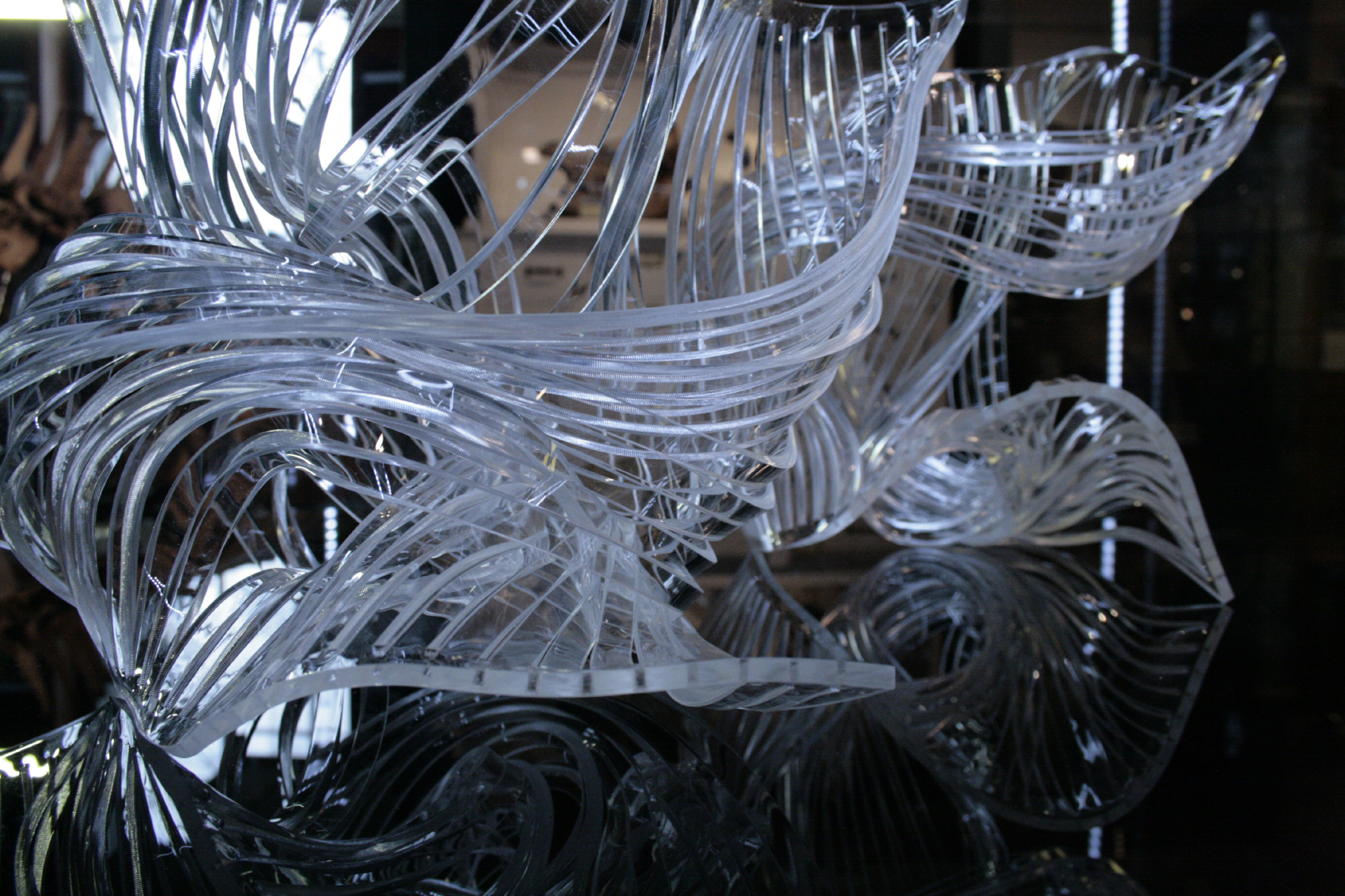Agonism/Antagonism
2017-2018
Acrylic and steel cable installation suspended above the Dugong skeleton, Grant Museum of Zoology.
Agonism / Antagonism is a project resulting from artist Neus Torres Tamarit’s residency in the laboratory of Dr Max Reuter, in the Research Department of Genetics, Evolution, and Environment at UCL, and part of a long-term collaboration with computer scientist Ben Murray.
This project explores the forces that drive and constrain genetic evolution. This focus, and the project artworks, are the result of Neus’ residency embedded in Max’s research group and conversations between Neus, Ben and Max. The artworks address the genetic concepts that are studied in Max’s laboratory, as well as the means and approaches that are used, such as the model organism Drosophila melanogaster, also known as the fruit fly. Neus has found inspiration in the aesthetics of the laboratory environment and connections between the media in which she has previously worked and the materials that constitute the fruit flies themselves.
Artworks include acrylic and bioplastic sculptures and installations, videocreations made of fruit fly CT scans and digitally programmed shapes, and virtual reality artworks that attempt to model genetic antagonism at two very different scales and in a non-didactic way.
What is genetic antagonism?
Darwin's 'survival of the fittest' captures natural selection in a form that is familiar to many. However, adaptive evolution is often not as simple as this catch-phrase implies. One aspect that is explored in this exhibition is adaptive constraint, where improvement in one aspect of an organism comes with negative effects in another aspect. This is a common problem for the evolution of male and female traits. Males and females perform different reproductive functions and are selected to show differences ranging from subtle variations in the morphology of internal organs to clearly contrasting body sizes, colouration or armaments. But developing these is far from easy, because both genders share a common genome and exchange genetic material every generation. This leads to a genetic coupling of their characteristics, where a mutation will tend to alter the genetic traits of both genders in a similar way. The combination between linked traits but opposing selection leads to a situation where genetic changes that alter a trait are beneficial to one sex but detrimental to the other—a phenomenon called genetic antagonism. Genetic antagonism can cause an evolutionary stalemate, where the sexes are stuck in an ongoing adaptive tug-of-war, with neither reaching their optimal trait value. To break the deadlock, genetic changes are required that allow males and females to use their genomes in a sex-specific way and express different phenotypes. Such resolution of sexual antagonism is thought to have occurred many times over evolutionary history, resulting in sometimes astonishing differences between the sexes. However, evidence is accumulating that suggests that this harmony is only superficial, with struggles continuing even in species with well-developed dimorphism between the sexes.
Digital prints on acrylic of one of the fruit fly cocoon CT scan and one of the 3D digitally programmed shapes.
Why Agonism / Antagonism?
Agonism, is an ancient Greek political theory that emphasises the importance and necessity of conflict within politics. We thought that is a good metaphor for genetic antagonism; its inevitability within sexually reproducing species implies that it is ultimately necessary for the fitness of a species in the wider world. Ultimately, genetic agonism might have been a better term for the phenomenon!
Dr Max Reuter's Research
Dr Max Reuter and his team use fruit flies (Drosophila melanogaster) to conduct research into the evolution of sexual dimorphism and how adaptive divergence between the sexes is constrained by the genetics of male and female traits.
Exhibition
Agonism / Antagonism was exhibited at the UCL Grant Museum of Zoology, 21 University Street, London WC1E 6DE from the 20th of September to the 21st of December 2018 with the private view on the 19th of September 2018.
https://www.ucl.ac.uk/museums-collections/grant-museum-zoology/about-us/projects/agonism-antagonism
https://blogs.ucl.ac.uk/museums/2018/09/21/new-grant-museum-exhibition-agonismantagonism-opens/

Installation comprised of two acrylic sculptures.
Virtual reality artwork.
Virtual reality artwork.
Microscopic videos of fruit fles cocoons and handmade bioplastic.
A fruit fly metamorphosis short film.
Fruit fly images coloured in ImageJ.
Acknowledgements
Thank you:
- Dr Max Reuter
- Alexander Kirby
- Florencia Camus
- Michael Jardine
- Filip Ruzicka
- Lara Meade
- Quentin Saintain
- Rebecca Finlay